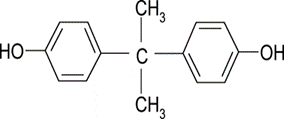1. Kafle A, Mohapatra S, Panigrahi S, Ganguly S. Enviromental Toxicology. In Ashok G. Matani, Dr. Shamal K. Doifode. Environment and Energy: Latest Progress. Delhi: International Research Publication House. 2018; 251-69. [
Link]
2. Fisher MR. Environmental biology. Revised ed. Oregon: creative commons. 2019. [
Link]
3. Dianin AP. Condensation of ketones with phenols. Zhurnal Russkogo Fiziko-Khimicheskogo Obshchestva. J. Russ. Phys. Chem. Soc. St. Petersburg. 1891;23(488-517):601-11. [
Link]
4. Zincke TH. Ueber die Einwirkung von Brom und von Chlor auf Phenole: Substitutionsproducte, Pseudobromide und Pseudochloride. Justus Liebigs Annalen der Chemie. 1905;343(1):75-99. [
Link]
5. Allard P, Colaiacovo P. Bisphenol A. In Gupta, R. Reproductive and developmental toxicology. USA: Esliver. 2011: 673-83. [
Link]
6. Shelby MD. NTP-CERHR - Monograph on the Potential Human Reproductive and Developmental Effects of Bisphenol A. Ntp cerhr mon. 2008; 22:v-ii. [
pmid: 19407859]
7. Allard P, Colaiácovo MP. Bisphenol A impairs the double-strand break repair machinery in the germline and causes chromosome abnormalities. Proceedings of the National Academy of Sciences. 2010;107(47):20405-10. [
doi:10.1073/pnas.1010386107]
8. Rocheste R. Bisphenol A and human health: A review of the literature. Reprod Toxicol. 2013; 42:132-155. [Link] [
Link]
9. Siracusa S, Yin L, Measel E, Liang S, Yu X. Effects of bisphenol A and its analogs on reproductive health: A mini review. Reprod Toxicol. 2018; 79:96-123. [
doi: 10.1016/j.reprotox.2018.06.005] [
pmid: 29925041]
10. Melzer D, Rice N, Lewis C, Henley W, Galloway T. Associacion of urinary bisphenol A concentration with heart disease: evidence from NHANES 2003/06. PLoS ONE. 2010; 5: 8673. [
doi:10.1371/journal.pone.0008673]
11. Hassan ZK, Elobeid MA, Virk P, Omer SA, ElAmin M, Daghestani MH, AlOlayan EM. Bisphenol A induces hepatotoxicity through oxidative stress in rat model. Oxidative medicine and cellular longevity. 2012;2012(1):194829. [
doi:10.1155/2012/194829]
12. Kuiper GG, Carlsson B, Grandien K, et al. Comparison of the ligand binding specificity and transcript tissue distribution of estrogen receptors alpha and beta. Endocrinology.1997;138:863-70. [
doi:10.1210/endo.138.3.4979]
13. Doerge R, Fisher W. Background Paper on Metabolism and Toxicokinetics of Bisphenol A. In FOOD, WHO/HSE/FOS/11.1 Expert Meeting on Bisphenol A (BPA), Ottawa, Canada. 2010: 1-20. [
Link]
14. Stowell L, Barvian K, Young C. et al. A role for sulfation-desulfation in the uptake of bisphenol a into breast tumor cells. Chem Biol. 2006;13:891-97. [
doi:10.1016/j.chembiol.2006.06.016]
15. Zalko D, Soto M, Dolo L, Dorio C, Rathahao E, Debrauwer L, et al. Biotransformations of bisphenol A in a mammalian model: Answers and new questions raised by low-dose metabolic fate studies in pregnant CD1 mice. Environmental Health Perspectives. 2003; 111:309-19. [doi: 10.1289/ehp.5603] [
DOI:10.1289/ehp.5603] [
PMID] [
]
16. Zalko D, Jacques C, Duplan H, Bruel S, Perdu E. Viable skin efficiently absorbs and metabolizes bisphenol A. Chemosphere. 2011;82(3):424-30. [
doi:10.1016/j.chemosphere.2010.09.058]
17. Wilson K, Chuang C, Lyu C, Menton R, Morgan K. Aggregate exposures of nine preschool children to persistent organic pollutants at day care and at home. J Expo Anal Environ Epidemiol.2003;13:187-202. [
doi:10.1038/sj.jea.7500270]
18. Wolff S, Teitelbaum L, Windham G. et al. Pilot study of urinary biomarkers of phytoestrogens, phthalates, and phenols in girls. Environ Health Perspect. 2007; 115(1):116-21. [
doi:10.1289/ehp.9488]
19. Volkel W, Colnot T, Csanady A, Filser G, Dekant W. Metabolism and kinetics of bisphenol A in humans at low doses following oral administration. Chem Res Toxicol. 2002;15:1281-7. [
Link]
20. Battal D, Cok I, Unlusayin I, Tunctan B. Development and validation of an LC-MS/MS method for simultaneous quantitative analysis of free and conjugated bisphenol A in human urine. Biomed Chromatogr. 2014; 28:686-93. [
doi:10.1002/bmc.3090]
21. Park K, Watanabe T, Gee J, Schenker B, Hammock D. Creatinine measurements in 24 h urine by liquid chromatography - tandem Mass Spectrometry. J Agric Food Chem.2008; 56(2):333-36. [
Link]
22. Perucca J, Bouby N, Valeix P, Bankir L. Sex difference in urine concentration across differing ages, sodium intake, and level of kidney disease. Am J Physiol Reg Integr Comp Physiol. 2007;292(2): R700-5. [
doi:10.1152/ajpregu.00500.2006]
23. Dekant W, Volkel W. Human exposure to bisphenol A by biomonitoring: methods, results and assessment of environmental exposures. Toxicol Appl Pharmacol. 2008; 228(1):114-34. [
doi:10.1016/j.taap.2007.12.008]
24. UNEP/WHO. State of the science of endocrine disrupting chemicals. 2012. [Link]
25. Geens T, Roosens L, Neels H, Covaci A. Assessment of human exposure to bisphenol-A, triclosan and tetrabromobisphenol-A through indoor dust intake in Belgium. Chemosphere. 2009;76:755-60. [
doi:10.1016/j.chemosphere.2009.05.024]
26. He Y, Miao M, Herrinton LJ, Wu C, Yuan W, Zhou Z, et al. Bisphenol A levels in blood and urine in a Chinese population and the personal factors affecting the levels. Environmental Research.2009; 109:629-33. [
doi:10.1016/j.envres.2009.04.003]
27. Ye X, Bishop AM, Needham LL, Calafat AM. Automated on-line column-switching HPLC-MS/MS method with peak focusing for measuring parabens, triclosan, and other environmental phenols in human milk. Analytica Chimica Acta, 2008; 622(1-2):150-56. [
doi:10.1016/j.aca.2008.05.068]
28. Health Canada - Report on Human Biomonitoring of Environmental Chemicals in Canada. Results of Canadian Health Measures Survey Cycle 1 (2007-2009). 2021. [
Link]
29. Ikezuki Y, Tsutsumi O, Takai Y, Kamei Y, TaketaniY. Determination of bisphenol-A concentrations in human biological fluids reveals significant earlyprenatal exposure. Human Reproduction (Oxford, UK). 2002;17:2839-41. [
doi:10.1093/humrep/17.11.2839]
30. Shiue I. Urine phthalates concentrations are higher in people with stroke: United States National Health and Nutrition Examination Surveys (NHANES), 2001-2004. European Journal of Neurology. 2013; 20(4): 728-31. [
doi:10.1111/j.1468-1331.2012.03862.x]
31. Calafat M, Ye Y, Wong Y, Reidy A, Needham L. Exposure of the US population to bisphenol A and 4-tertiary-octylphenol: 2003-2004. Environ Health Perspect. 2008;116(1):39-44. [doi: 10.1289/ehp.10753] [pmid: 18197297] [
doi:10.1289/ehp.10753] [
pmid: 18197297]
32. Völkel W, Kiranoglu M, and Fromme H. Determination of free and total bisphenol A in urine of infants. Environmental Research. 2011; 111:143-8. [
DOI:10.1016/j.envres.2010.10.001]
33. Casas L, Fernandez MF, Llop S, Guxens M, Ballester F, Olea N. et al. Urinary concentrations of phthalates and phenols in a population of Spanish pregnant women and children. Environmental International. 2011; 37:858-6. [
doi:10.1016/j.envint.2011.02.012]
34. Bushnik T, Haines D, Levallois P, Levesque J. Lead and bisphenol A concentrations in the Canadian populations. Statistics of Canada Health Reproduction. 2010; 21(3):7-18. [
Link]
35. Sabanayagam C, Teppala S, Shankar A. Relationship between urinary bisphenol A levels and prediabetes among subjects free of diabetes. Acta Diabetol . 2013; 50:625-31. [
doi:10.1007/s00592-013-0472-z]
36. Trasande L, Attina M, and Blustein J. Association between urinary bisphenol A concentration and obesity prevalence in children and adolescents. JAMA. 2012; 308:1113-21. [
Link]
37. Alshana U, Lubbad I, Goger NG, Cok I, Tamer U, Ertas N. Dispersive liquid-liquid microextraction based on solidification of floating organic drop combined with counter-electroosmotic flow normal stacking mode in capillary electrophoresis for the determination of bisphenol A in water and urine samples. Journal of Liquid Chromatography and Related Technologies. 2013; 36: 2855-70. [
doi:10.1080/10826076.2012.725700]
38. Calafat M, Needham L. Factors affecting the evaluation of biomonitoring data for human exposure assessment. International Journal of Andrology. 2008 ;31(2):139-43. [
doi:10.1111/j.1365-2605.2007.00826.x]
39. Brock JW, Yoshimura Y, Barr JR, Maggio VL, Graiser SR, Nakazawa H, et al. Measurement of bisphenol A levels in human urine. J Expo Sci Environ Epidemiol . 2001; 11(4):323-8. [
doi:10.1038/sj.jea.7500174]
40. Wolff MS, Engel SM, Berkowitz GS, Ye X, Silva MJ, Zhu C, et al. Prenatal phenol and phthalate exposures and birth outcomes. Environ Health Perspect. 2008; 116:1092-97. [
doi:10.1289/ehp.11007]
41. Zhang Z, Alomirah H, Cho HS, Li YF, Liao C, Minh TB, et al. Urinary Bisphenol A Concentrations and Their Implications for Human Exposure in Several Asian Countries. Environ Sci Technol. 2011 ;45(16):7044-50. [
doi:10.1021/es200976k]
42. Becker K, Göen T, Seiwert M, Conrad A, Pick-Fub H, Müller J, et al. Phthalate metabolites and bisphenol A in urine of German children. International Journal of Hygiene and Environmental Health. 2009; 212:685-92. [
doi:10.1016/j.ijheh.2009.08.002]
43. Liao C, Kannan K. Determination of free and conjugated forms of bisphenol A in human urine and serum by liquid chromatography & tandem mass spectrometry. Environ Sci Technol. 2012; 46(9): 5003-9. [
doi:10.1021/es300115a]
44. Takeuchi T, Tsutsumi O. Serum bisphenol-A concentrations showed gender differences, possibly linked to androgen levels. Biochemical and Biophysical Research Communications. 2002; 291(1):76-8. [
doi:10.1006/bbrc.2002.6407]
45. Huang P, Liu ZH, Yuan SF, Yin H, Dang Z, Wu PX. Worldwide human daily intakes of bisphenol A (BPA) estimated from global urinary concentration data (2000-2016) and its risk analysis. Environ Pollut. 2017; 230:143-52. [
doi:10.1016/j.envpol.2017.06.026]










































 SD
SD 13.95
13.95 12.68
12.68
